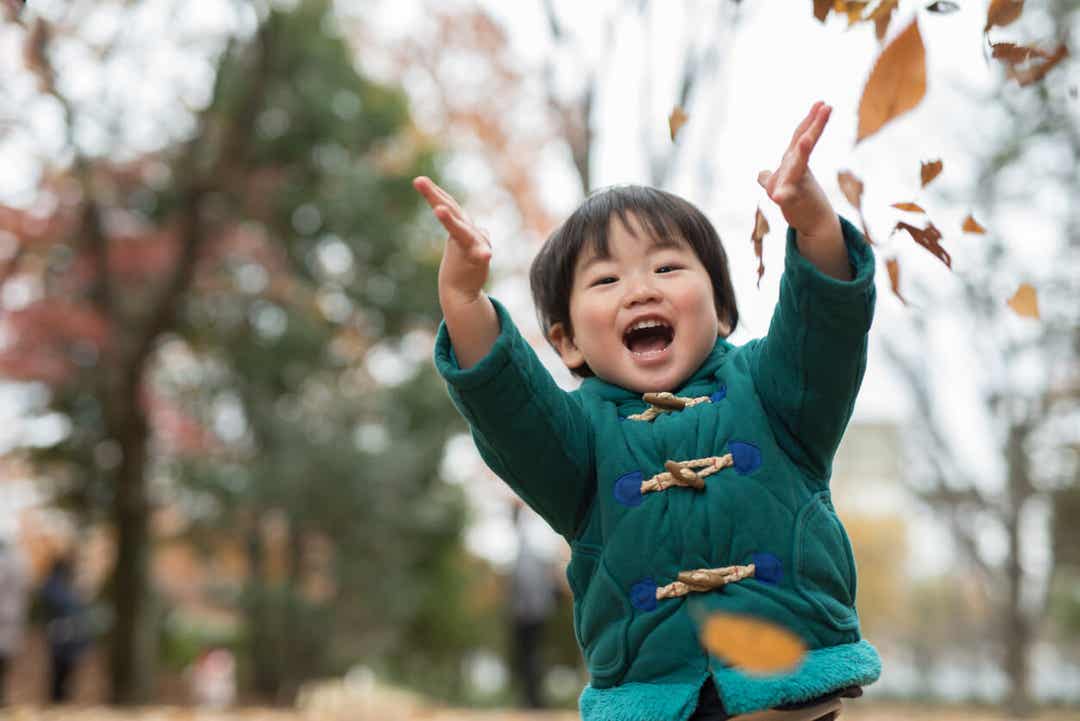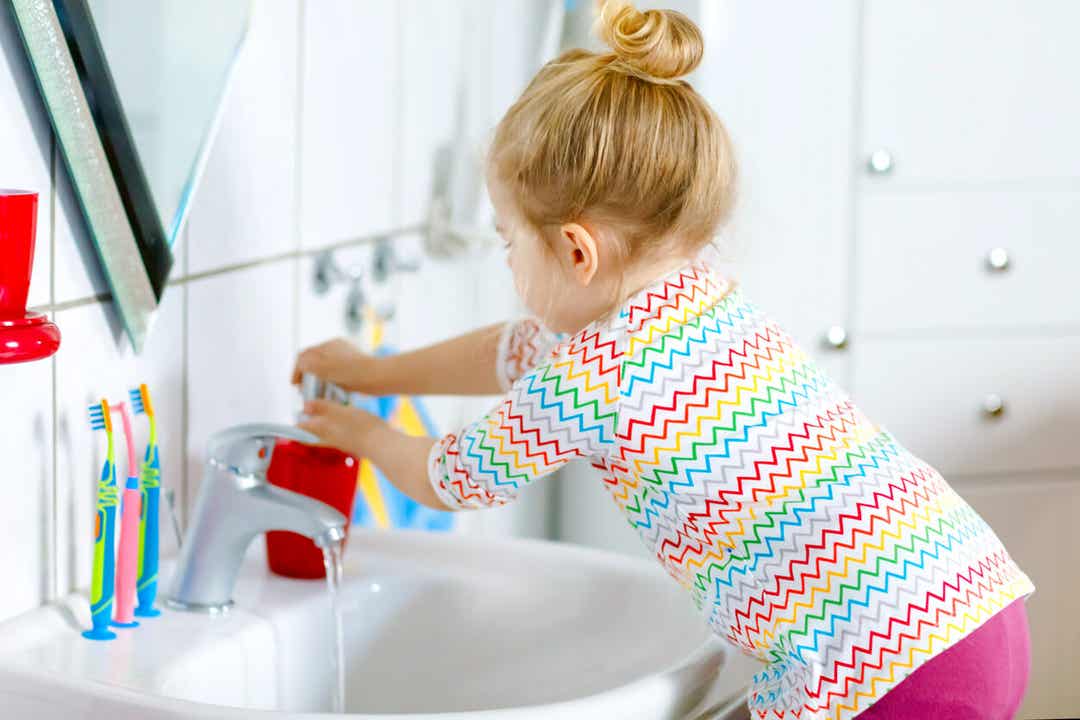What Children Learn at the Age of Three

Three-year-olds are a whirlwind of emotions and intensity in all their feelings. It’s wonderful to see how they grasp everything around them and evolve in a magical way while parents enjoy seeing it first hand. That’s why we’re going to talk to you about what children learn at age three.
What children learn at the age of three: remember, everyone has their own pace!
Although we’re going to talk about some of the most important milestones at this stage, it’s worth remembering that it’s not the same for all children. Little ones have different learning rhythms and you have to respect them. You shouldn’t want to rush their learning but, rather, stimulate them, empower them, guide them… never overwhelm them in order to advance more quickly.
On that same note, don’t compare your three-year-old child with other children of the same age. There are children who’ll advance faster, while others will remain stagnant and have more difficulty in their daily learning. But all of them, with the necessary stimulation, will be able to advance in a stable way in terms of their learning.

Influences of the environment on three-year-olds
Of course, the development of little ones and everything they learn in this sweet stage is influenced by their innate capacity, their environment, the stimuli they receive from it, the experiences they have at home and at school, and how the people around them are able to motivate them to continue their learning and intellectual and emotional growth.
Just the same, below, we’re going to explain some of the things that children learn at the age of three. But remember that it’s only a general guide. If your child has already learned it or is still in the process of learning, that’s okay too.
Things children learn at three years of age
Every child’s different and their learning pace should be respected. Always accompany them with affection, even in the most difficult moments, such as when they’re having a tantrum in the middle of the street.
A real explorer
All children at this age are true explorers and their senses are their teachers. They use them all to the fullest to sense their surroundings and absorb the information that their senses provide. They’re increasingly able to concentrate and think creatively – but they can solve simple problems adapted to their age!
What do children learn at the age of three? That’s mine!
“No! It’s mine! Gimme!” Will be some of their favorite words. Your little one’s becoming more and more aware that they’re an independent being to their parents, so they’ll want to make this clear at every moment. They’ll be able to do this by showing selfishness and self-centeredness, which are both natural at this age.
So don’t get angry if they don’t want to share at first. As we said, it’s normal and natural at this age. Just guide him to be empathetic and generous with themselves and others.
More vocabulary at three years old
It seems like just yesterday, your little one barely could barely say two words per sentence and only you and other members of your household understood them correctly. Now their vocabulary is growing in leaps and bounds and they’re able to say more complete sentences and carry on a small conversation. The things they like will capture their attention and they’ll want to talk about them and explore them to the fullest.
In fact, they’ll also be able to understand conversations with more words, remember songs or short poems, and, if you tell him a story, they’ll pay attention to you if they find it interesting! Seeing their bright eyes full of motivation is such a gift.
What do children learn at the age of three? They’re capable of so much!
Now you’ll notice that they’re increasingly able to do more and more things on their own. They used to require your help for these activities, but now they’re able to enjoy doing them by themselves:

- Sort and classify objects.
- Pick up toys from their room.
- Do simple puzzles suitable for their age.
- Understand more about the things around them.
- Play for longer periods of time in a focused way.
- Use logical reasoning.
- Notice similarities and differences.
- Know and understand numbers 1-10.
- Have more fine and gross motor skills.
- Begin to make friends.
- Seek solutions to conflicts that arise from playing with others.
- Need emotional security from adult role models.
- Enjoy the symbolic play.
- Recognize their first initial and written name.
- Know how to write their first initial. They’ll also begin to try to scribble their name.
- Their drawings are becoming more and more understandable.
- Imaginary friends may appear.
As you can see, a three-year-old child is a box full of surprises, magic, and emotions that just wants to keep learning. Every child’s different and your child is sure to develop normally. So don’t rush them and respect their developmental rhythm. If you have any doubts about their development, always ask your pediatrician to monitor their evolution.
Three-year-olds are a whirlwind of emotions and intensity in all their feelings. It’s wonderful to see how they grasp everything around them and evolve in a magical way while parents enjoy seeing it first hand. That’s why we’re going to talk to you about what children learn at age three.
What children learn at the age of three: remember, everyone has their own pace!
Although we’re going to talk about some of the most important milestones at this stage, it’s worth remembering that it’s not the same for all children. Little ones have different learning rhythms and you have to respect them. You shouldn’t want to rush their learning but, rather, stimulate them, empower them, guide them… never overwhelm them in order to advance more quickly.
On that same note, don’t compare your three-year-old child with other children of the same age. There are children who’ll advance faster, while others will remain stagnant and have more difficulty in their daily learning. But all of them, with the necessary stimulation, will be able to advance in a stable way in terms of their learning.

Influences of the environment on three-year-olds
Of course, the development of little ones and everything they learn in this sweet stage is influenced by their innate capacity, their environment, the stimuli they receive from it, the experiences they have at home and at school, and how the people around them are able to motivate them to continue their learning and intellectual and emotional growth.
Just the same, below, we’re going to explain some of the things that children learn at the age of three. But remember that it’s only a general guide. If your child has already learned it or is still in the process of learning, that’s okay too.
Things children learn at three years of age
Every child’s different and their learning pace should be respected. Always accompany them with affection, even in the most difficult moments, such as when they’re having a tantrum in the middle of the street.
A real explorer
All children at this age are true explorers and their senses are their teachers. They use them all to the fullest to sense their surroundings and absorb the information that their senses provide. They’re increasingly able to concentrate and think creatively – but they can solve simple problems adapted to their age!
What do children learn at the age of three? That’s mine!
“No! It’s mine! Gimme!” Will be some of their favorite words. Your little one’s becoming more and more aware that they’re an independent being to their parents, so they’ll want to make this clear at every moment. They’ll be able to do this by showing selfishness and self-centeredness, which are both natural at this age.
So don’t get angry if they don’t want to share at first. As we said, it’s normal and natural at this age. Just guide him to be empathetic and generous with themselves and others.
More vocabulary at three years old
It seems like just yesterday, your little one barely could barely say two words per sentence and only you and other members of your household understood them correctly. Now their vocabulary is growing in leaps and bounds and they’re able to say more complete sentences and carry on a small conversation. The things they like will capture their attention and they’ll want to talk about them and explore them to the fullest.
In fact, they’ll also be able to understand conversations with more words, remember songs or short poems, and, if you tell him a story, they’ll pay attention to you if they find it interesting! Seeing their bright eyes full of motivation is such a gift.
What do children learn at the age of three? They’re capable of so much!
Now you’ll notice that they’re increasingly able to do more and more things on their own. They used to require your help for these activities, but now they’re able to enjoy doing them by themselves:

- Sort and classify objects.
- Pick up toys from their room.
- Do simple puzzles suitable for their age.
- Understand more about the things around them.
- Play for longer periods of time in a focused way.
- Use logical reasoning.
- Notice similarities and differences.
- Know and understand numbers 1-10.
- Have more fine and gross motor skills.
- Begin to make friends.
- Seek solutions to conflicts that arise from playing with others.
- Need emotional security from adult role models.
- Enjoy the symbolic play.
- Recognize their first initial and written name.
- Know how to write their first initial. They’ll also begin to try to scribble their name.
- Their drawings are becoming more and more understandable.
- Imaginary friends may appear.
As you can see, a three-year-old child is a box full of surprises, magic, and emotions that just wants to keep learning. Every child’s different and your child is sure to develop normally. So don’t rush them and respect their developmental rhythm. If you have any doubts about their development, always ask your pediatrician to monitor their evolution.
All cited sources were thoroughly reviewed by our team to ensure their quality, reliability, currency, and validity. The bibliography of this article was considered reliable and of academic or scientific accuracy.
- Aguado Aloso, F. (2012) El Desarrollo del Lenguaje de 0 a 3 Años. Bases para un diseño curricular en la Educación Infantil. Editorial: CEPE
This text is provided for informational purposes only and does not replace consultation with a professional. If in doubt, consult your specialist.








